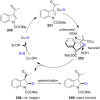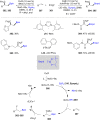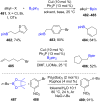Recent advances in Cu-catalyzed C(sp3)-Si and C(sp3)-B bond formation
- PMID: 32362947
- PMCID: PMC7176932
- DOI: 10.3762/bjoc.16.67
Recent advances in Cu-catalyzed C(sp3)-Si and C(sp3)-B bond formation
Abstract
Numerous reactions generating C-Si and C-B bonds are in focus owing to the importance of incorporating silicon or boron into new or existing drugs, in addition to their use as building blocks in cross-coupling reactions en route to various targets of both natural and unnatural origins. In this review, recent protocols relying on copper-catalyzed sp3 carbon-silicon and carbon-boron bond-forming reactions are discussed.
Keywords: C–B bonds; C–Si bonds; copper catalysis; enantioselective reactions; sp3 carbon functionalization.
Copyright © 2020, Takale et al.; licensee Beilstein-Institut.
Figures
















































































Similar articles
-
Silicon-Tethered Strategies for C-H Functionalization Reactions.Acc Chem Res. 2017 Aug 15;50(8):2038-2053. doi: 10.1021/acs.accounts.7b00306. Epub 2017 Aug 3. Acc Chem Res. 2017. PMID: 28771325 Free PMC article.
-
Diastereoselective sp3 C-O Bond Formation via Visible Light-Induced, Copper-Catalyzed Cross-Couplings of Glycosyl Bromides with Aliphatic Alcohols.ACS Catal. 2020 Jun 5;10(11):5990-6001. doi: 10.1021/acscatal.0c01470. Epub 2020 Apr 29. ACS Catal. 2020. PMID: 34168901 Free PMC article.
-
Copper-Catalyzed Radical Relay for Asymmetric Radical Transformations.Acc Chem Res. 2018 Sep 18;51(9):2036-2046. doi: 10.1021/acs.accounts.8b00265. Epub 2018 Sep 5. Acc Chem Res. 2018. PMID: 30183262
-
Catalytic alkylation of unactivated C(sp3)-H bonds for C(sp3)-C(sp3) bond formation.Chem Soc Rev. 2019 Sep 16;48(18):4921-4942. doi: 10.1039/c9cs00086k. Chem Soc Rev. 2019. PMID: 31403147 Review.
-
Recent Advances in Transition-metal-catalyzed C-C Bond Formation via C(sp2 )-F Bond Cleavage.Chem Rec. 2021 Dec;21(12):3394-3410. doi: 10.1002/tcr.202100053. Epub 2021 Apr 14. Chem Rec. 2021. PMID: 33852203 Review.
Cited by
-
Inorganometallics (Transition Metal-Metalloid Complexes) and Catalysis.Chem Rev. 2022 Feb 9;122(3):3996-4090. doi: 10.1021/acs.chemrev.1c00417. Epub 2021 Dec 30. Chem Rev. 2022. PMID: 34967210 Free PMC article. Review.
-
Beyond Carbon: Enantioselective and Enantiospecific Reactions with Catalytically Generated Boryl- and Silylcopper Intermediates.ACS Cent Sci. 2020 Jul 22;6(7):1070-1081. doi: 10.1021/acscentsci.0c00738. Epub 2020 Jul 9. ACS Cent Sci. 2020. PMID: 32724842 Free PMC article. Review.
-
The current utility and future potential of multiborylated alkanes.Nat Rev Chem. 2024 Oct;8(10):741-761. doi: 10.1038/s41570-024-00650-x. Epub 2024 Sep 26. Nat Rev Chem. 2024. PMID: 39327469 Review.
-
Enantioselective Aminosilylation of Alkenes by Palladium/Ming-Phos-Catalyzed Tandem Narasaka-Heck/Silylation Reaction.Adv Sci (Weinh). 2024 Sep;11(34):e2403470. doi: 10.1002/advs.202403470. Epub 2024 Jul 5. Adv Sci (Weinh). 2024. PMID: 38970207 Free PMC article.
-
Nickel boryl complexes and nickel-catalyzed alkyne borylation.Chem Sci. 2023 Jan 27;14(8):2215-2228. doi: 10.1039/d2sc04690c. eCollection 2023 Feb 22. Chem Sci. 2023. PMID: 36845942 Free PMC article.
References
Publication types
LinkOut - more resources
Full Text Sources
Research Materials
